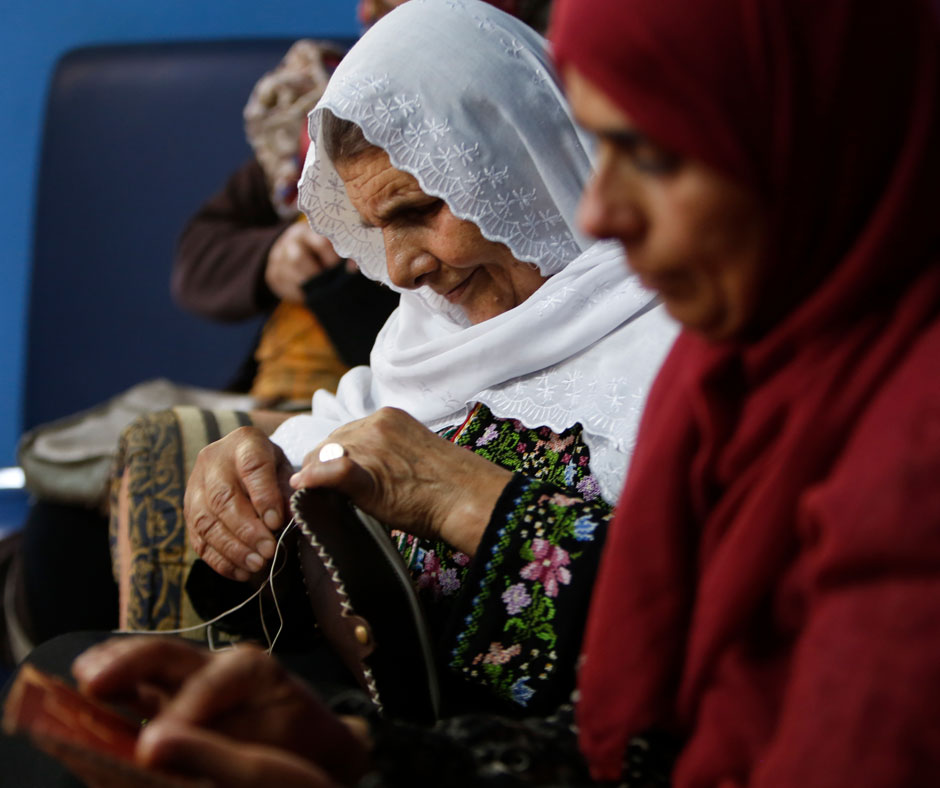Photo courtesy of braneandnina.blogspot.com
A couple of days ago, I went in, sitting there were a couple, with signs frustration on their faces. They didn't give me much attention which explained their frustration later. After a couple of questions about the displayed crafts which ranged from Handmade Ceramics, to Embroidered Accessories, Shawls and Dresses; the woman started opening up - while the man remained hopeless, and started complaining about how bad business was; ,many of the handicrafts caught my attention, so I asked if I can take photos as to show them to Morgan. She refused saying, many visitors take photos trying to copy our designs, while we are running out of business due to high competition.
While I was asking about prices, I stumbled upon a very beautiful cushion cover - in the photo below - I asked her about the price, she answered 160 shekels (~ $40). I was shocked, then immediately asked how much time does it take to finish such piece? She answered with a smile, a month.
I know it takes less than a month to make, not even two weeks but still, if we were to make a simple calculation based on 10 days work that's almost paying the maker ~$3 a day taking profit margin of the seller out of the equation!
I'm not writing this example to blame the owners of the store, they are also doing their best to support the women artisans they work with, my aim here is to give examples of the lives of these artisans, in simple numbers.
She explained more about their women association in Kuft Ni'ma - a small village to the west of Ramallah - and how they support women by hosting capacity building programs, to help integrate women in work activities. Later when they are employed, their earnings don't exceed $190-$215. Yet these are supported by the association, which gives them an opportunity to work, develops and enables them to sustain themselves in the future. But what if they came from poorer areas, where they have no support and some accept to work for less than $2/day, and have no other option but to accept that as a wage?
In my experience at Handmade Palestine, a lot of customers frequently ask why are the prices high? Well, if we were to make a simple calculation, we would understand why some prices are higher.
Ask before you purchase?
If we are buying handmade crafts, awesome but maybe we should know a little more. It should not be enough to buy artisanal gifts and be happy to have passively supported an artisan. It's important to ask who made them? Under what circumstances? And if the makers were paid enough to sustain their lives and the lives of their children? When we say that many of the artisans we work with are women, and in many instances they are the sole providers of their families, we mean that. It's not a selling point, it's a fact. And if one compares the price of a handmade leather bag from Hebron, with the price of a mass produced leather bag from China, the China bag is obviously cheaper and affordable, but who is that supporting?
Example from an upcoming artisan
In the same instance, a while ago, Rawan, an artisan who makes crocheted bags from plastic/nylon bags came by to La Vie Cafe in Ramallah, to show us samples of her work. The girl seemed to be in love with what she is doing. To her this is a method to up-cycle nylon bags, and she is making an unconventionally, very beautiful product.
Discussing the pricing, she explained that it takes her almost a week to finish one of these from cutting and folding the nylon to crocheting and finishing. That's 56 hours of work, if she's to price it, paying $2.5 per hour which is an average wage, that's $140 per bag; taking raw material out of the equation because she collects nylon bags for free. This would be a somehow fair price, but according to feedback from her friends and family they said that they would pay a price of $19-$23. Because afterall, its made from nylon, and they would only use it for grocery shopping.
Facing reality
What's the point here? what's fair trade? Where are these poor women in this equation, whereas the seller in many instances, gets the larger buck while the makers can barely sustain themselves. How will these girls, who are facing gender inequalities on daily basis, seek independence from male domination? How can they raise a new generation that's free, when making enough money to put food on their tables is their only concern.
What do you think? Please join me in this discussion by sharing this on your favorite social media platform or down below in the comments.









1 comment
comment
Majdi Habash
Leave a comment
This site is protected by hCaptcha and the hCaptcha Privacy Policy and Terms of Service apply.